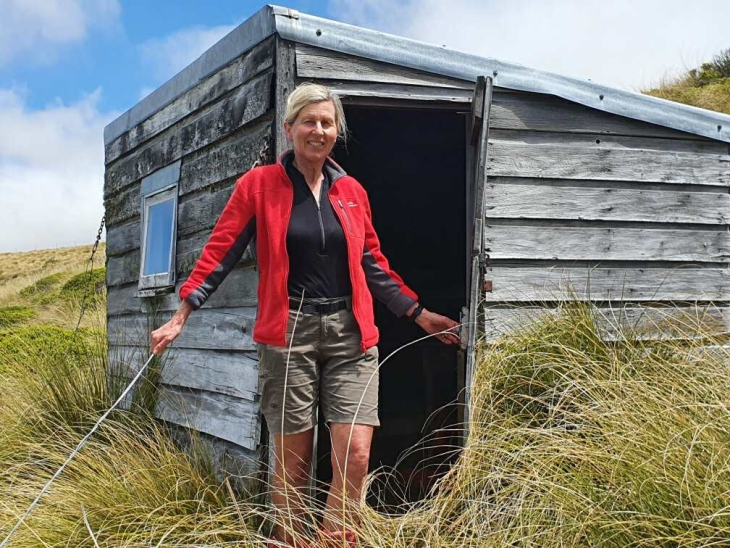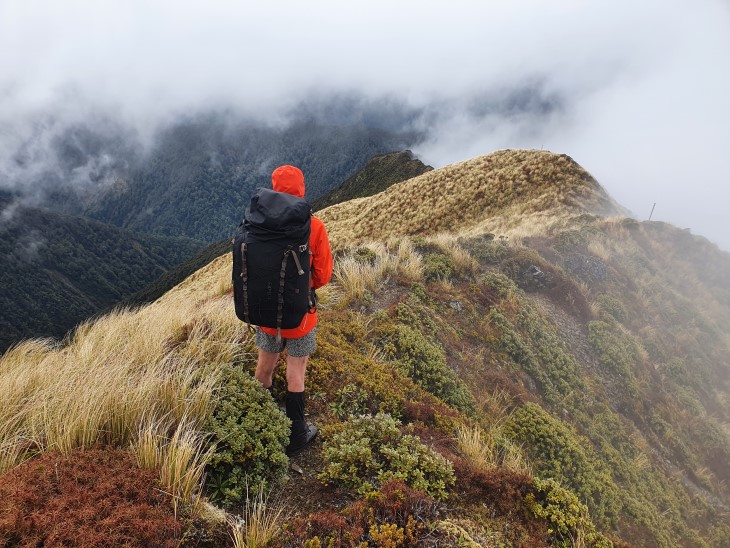Liz’s story: Tramper shares wise words after injury ordeal

After suffering a nasty injury on a remote tramping trail, Liz Wightwick feared the worst. She had to be airlifted to safety and has some wise words for fellow trampers to avoid going through such an ordeal.
Experienced tramper Liz Wightwick was stranded in the middle of the Ruahine mountain ranges, two days’ walk from the park exit, with blood gushing from her knee.
The 62-year-old from Christchurch had just tripped while heading down a steep ridge on Mt Rongotea, ‘shredding’ her leg on sharp rocks as she grabbed onto a tussock to stop her fall.
“I was really in shock because I could see that we were stuck,” Liz says.
“It was a two-day walk to get anywhere. And there’s blood pouring out. I even started hyperventilating because of the shock.”
Liz was halfway through an eight-day tramp with husband Ian last October when the incident occurred.
It was one of the couple’s many tramping trips – Liz has been hitting New Zealand’s many stunning trails for decades and estimates she has spent 100 days in the hills since the start of 2022 alone.
She had never had a major accident. Suddenly, stranded and in great pain at about 1500 metres above sea level, she knew she was in trouble.
“I self-arrested and only fell one metre, which is phenomenal considering the circumstances,” she says.
“I could see myself going head-first down the hill, and I quickly reached with my right hand and grabbed a tussock and that swung me round. So I saved myself from a bad fall.”

‘You’ve done more than bang your knee’
Liz initially thought she had only taken a knock to the knee.
“I said to Ian, ‘Give me a minute, I’ve just fallen, and my knee’s really sore’.
“He looked up and saw the blood and he said, ‘You’ve done more than bang your knee’.
“The blood was pouring out by this stage – it was a great big eight-centimetre gash in my leg. It had just opened up.”
Wightwick stopped the bleeding with a bandage from a first aid kit, and the pair decided to head to the nearest hut – which was a further 600m down the hill – and call for help by activating Liz’s personal locator beacon. It was a slow and painful two-hour trek.
An emergency air ambulance arrived an hour later and whisked the pair away to Hawke’s Bay Hospital in Hastings, where Liz was given 11 stitches and antibiotics.
The pilot told her that if she had activated her beacon 30 minutes later, the helicopter would not have been able to land because the weather was getting worse.
The patch-up job was not straightforward and the wound later became infected. A follow-up procedure was required to clean the wound, six weeks after the accident.
It was two months before Liz could walk on the injured leg again and three months before she could return to tramping.
ACC played a leading role in Liz’s recovery, helping to fund her treatment, the air ambulance service, doctor’s appointments and physiotherapy.

Paying the price for pushing it
Liz says multiple factors contributed to her accident, including fatigue and a lapse in concentration after completing a difficult part of the track. The weather was also wet and rainy, which made conditions difficult.
“We were going down a very steep ridge where I had to really focus, and I was being super careful,” she says.
“But at about the 1500m elevation mark, I saw the bush line ahead of me and the track had mellowed out. I think I just relaxed because I saw the bush line and thought ‘I’m there, I’m going to be okay’.”
Liz had also felt tired that morning. She and Ian had been putting in 10-hour days and she had not slept well the previous couple of nights.
Even though she was aware of her tiredness and had planned to take it slowly, the fatigue still got the better of her in the end.
Her message to others is to listen to your body and not push it.
“If you’re tired, either stop and rest, or have a rest day. I didn’t listen to myself. I thought, ‘I can do this, I can carry on’.”

Tramping injuries by the numbers
Over the last five years, there have been an average of more than 6,500 tramping-related injury claims each year.
Last year, we accepted nearly 7,800 new claims for tramping-related injuries, up from 5,657 claims in 2018.
The figures show tramping-related injuries generally peak between January and April as Kiwis hit the trails over the warmer months and take advantage of some long weekends and school holidays.
ACC injury prevention leader James Whitaker says it’s great that people are getting out into nature and tackling New Zealand’s tracks and trails, but it’s crucial to be prepared and make safe decisions.
“Always tramp with other people, stick together and make decisions as a group, and tell someone else where you’re going and when you expect to be back,” he says.
It’s also important to choose a track that suits everyone’s abilities, and check the weather forecast, both in advance and on the day.
“If in doubt, don’t go out. And always be prepared for the weather to change – even if it looks like it’s going to be great.”

‘Have a hmmm’ to stay safe on the trails
James says research shows 90 per cent of all injuries are predictable and therefore preventable, and tramping-related injuries are no different.
Incident analysis from the New Zealand Mountain Safety Council shows most walking and tramping injuries can be prevented, or their seriousness reduced, by thorough trip planning and sound decision-making.
“It’s really easy to underestimate the importance of quality planning and preparation. There are lots of little things that can be easily overlooked,” chief executive Mike Daisley says.
“Whether it’s a short walk, a day trip, or an overnight tramp, the bare minimum should be: warm clothes (insulation layers and thermal base layers), rain jacket, head torch, extra layers, and an appropriate emergency communications device.”





